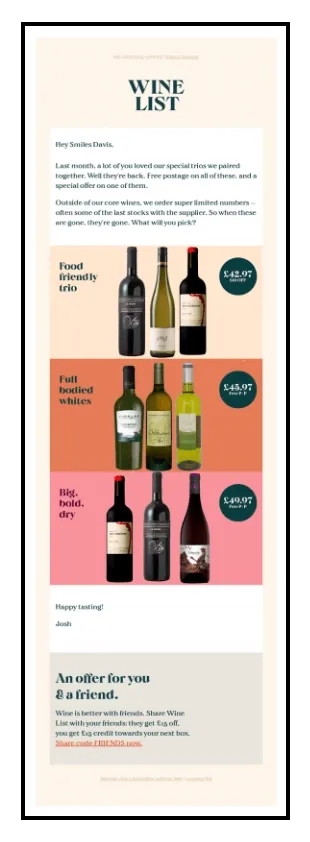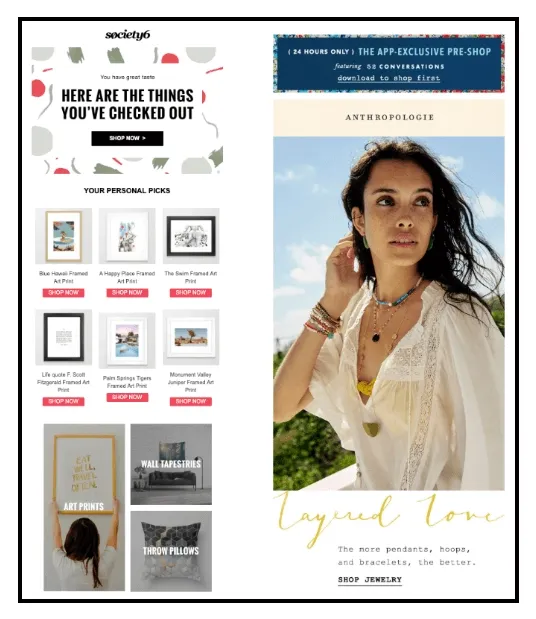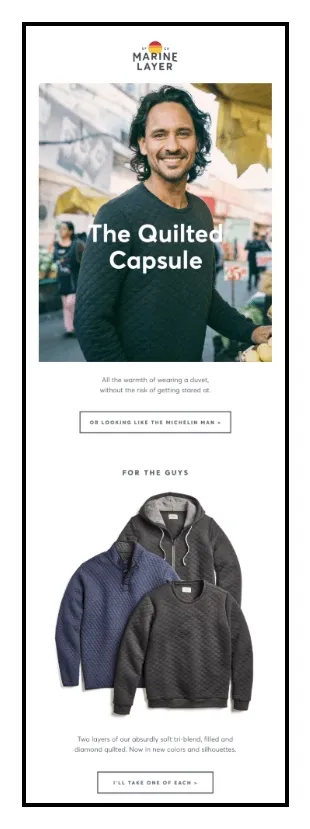The importance of personalization cannot be overstated as an email marketer:
- According to research, 74% of marketers believe that personalization improves the overall level of customer engagement.
- Custom subject lines have a 50% higher open rate than generic ones, and personalized CTAs are 200% more effective at converting subscribers than generic ones.
These are just a few of the many success stories of marketers who have used personalization to create customized emails. For instance, a DTC apparel brand could use a hyper-personalized email to inform customers that an item they’ve been “viewing” is now on sale. The same email can also suggest related products they might like.
As a result of such personalization, you can increase customer engagement and conversion rates and vastly improve their overall experience with your brand.
According to a Statista report, email marketing channels will reach 4.6 billion worldwide users by 2025.

Before we delve into personalization, let’s quickly understand that segmentation and personalization are two distinct concepts though sometimes, they’re talked about under the same breath.
Segmentation vs. personalization
Segmentation
Customers can be divided into segments based on a variety of criteria, such as geographic location, gender, age range, product affinity, and past purchase behavior/history. You can also segment customers based on their RFM analysis.
In most cases, a CRM or CRM-like system, normalized data and attributes tied to a targetable ID, and an understanding of different buyer types that coordinate to different product affinities are required to implement this type of marketing strategy.
Personalization
Personalization entails creating unique experiences for individual customers based on factors such as product, content, or offer recommendations, and the priority and timing of your communications.
You can achieve relevance and specific business outcomes by personalizing your content.
To develop a personalization strategy, you can use segmentation (manually), but segmentation does not imply personalization.
For example, if you have a list of people who have purchased navy blue trousers in the past and you send them a one-time email highlighting navy blue trousers, you are segmenting your list.
Personalization, on the other hand, occurs when you compile a list of people who have previously purchased navy blue trousers from your website, send them an email with personalized product recommendations based on their browsing habits, and then use send-time optimization to ensure that the email arrives at the inbox of each recipient at the optimal moment.
Note that both examples have the same audience, but the second example provides each recipient with recommendations based on their past behavior and predicted interests, and it ensures that the email is delivered at a time when they are most likely to engage. The result is a truly personalized experience for each individual in the audience.
Components of an email that can be personalized
Thanks to email marketing automation tools that use machine learning (ML) and artificial intelligence (AI), it is now possible to deliver personalized emails at scale.
People are tired of viewing the same old emails which are blasted in bulk, so it’s more important than ever before to present new customized perspectives. A marketing campaign’s success also depends on its visual diversity.
So, an email marketing automation tool enables you to still send bulk emails to your list, but with hyper-personalized content that varies by the recipient.
Apart from personalizing subject lines and receiver and sender names, which are passe, an email marketing automation tool enables you to easily hyper-personalize the following components of your email:
- Dynamic product recommendations that populate for each receiver based on factors like co-purchase patterns, next-best purchase recommendations, what other customers in the same segment purchase, or predicted affinities
- Dynamic content (including copy, product images, usage metrics, CTAs) and offers that populate for each individual based on factors like discount preference, customer lifecycle stage, and purchase history
- Dynamic send times to optimize for engagement with each receiver
For instance, this Back-in-Stock email from Wine List clearly personalizes the email body, the offer, the product bundle, and product images based on past purchases:

The email marketing automation tool also provides you with the following benefits:
- Email design/template picker options
- Email list management
- Advanced reporting and analytics
- Optimization tools for A/B testing
How to personalize bulk/mass emails beyond segmentation
You should configure the right email marketing tool or CDP while setting up your email campaigns and hyper-personalize it based on your customer’s real-time behavior data. Such tools will automate your bulk email campaigns with high levels of personalization via:
Dynamic components: Within individual campaigns, emails can display specific content to recipients who meet predefined conditions. You can create standard content templates via dynamic components, with each email containing several different dynamic blocks to ensure the body displays very differently depending on the recipients.
Automation email flows: You can set up automation email flows to set up segmented emails based on certain predefined behavior or spend thresholds (triggers). The appropriate contacts will receive follow-up emails based on their previous emails’ open rate behavior. This is a great way to schedule and send out automated reminder emails based on the funnel stage of the contacts. Examples of such automated emails are: welcome, abandoned cart, back-in-stock, post-purchase, and winback emails.Get Lifesight’s email templates.
For instance, if you browse through the Society6 site, they send an email containing several of the items that you would have viewed. This is an excellent browse abandonment email that will remind recipients of the products they saw the most and may still desire. Also, each link in this email links directly to the depicted work of art, which is really nice:

What is more pertinent to daily life than the weather? It’s how we choose what to wear in the morning, and it’s the first topic of small conversation.
Personalizing emails based on location (to recipients in that location) is a terrific approach to interacting with people living in specific climates and tying email content to their daily lives.
Marine Layer sends out such emails in the winter to its email subscribers in the Midwest by sending an email with the subject line “Quilts to get you through this cold spell.” The cold-spell theme is threaded throughout the email to produce a consistent, individualized message, and not just in the subject line.
The language “All the warmth of wearing a duvet without the risk of being stared at” and the CTA “Or looking like the Michelin Man” do a fantastic job of drawing you into the email:

Outcomes to measure
Email open rates, click-through rates (CTRs), and conversion rates can all be used to gauge the success of your personalization efforts.
So, which one should you be measuring? There is no one-size-fits-all answer to this question.
The open rate, for example, is an important success metric if you’re customizing subject lines based on user languages, segments, or behaviors.
It’s important to keep an eye on click-through rates and conversion rates when personalizing copy, images, and CTAs.
Grow your business with personalized emails, at scale
Step up from blasts-for-all, generic emails. Hyper-personalized segmented email campaigns can increase your conversion rates by more than 60%, so why leave money on the table?
Customer’s personal information, shopping history, and other filters can be used to create audience segments that can then be targeted in your personalized email marketing efforts.
You may also like
Essential resources for your success

























































